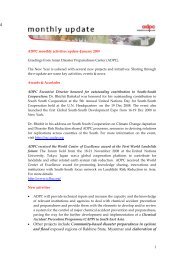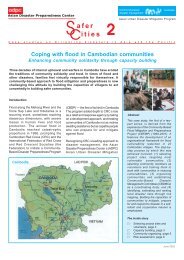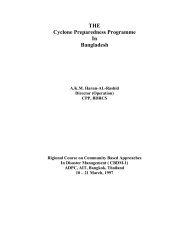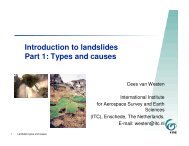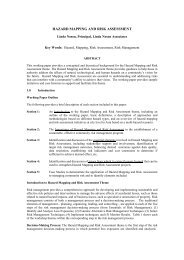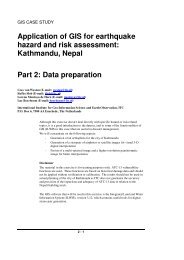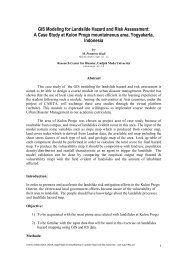community-based disaster risk management and the media media kit
community-based disaster risk management and the media media kit
community-based disaster risk management and the media media kit
You also want an ePaper? Increase the reach of your titles
YUMPU automatically turns print PDFs into web optimized ePapers that Google loves.
chapter 1. introduction to <strong>disaster</strong> <strong>risk</strong> <strong>management</strong><br />
5. Streng<strong>the</strong>n <strong>disaster</strong> preparedness for effective response at all<br />
levels.<br />
Key activities:<br />
• Disaster <strong>management</strong> capacities: policy, technical <strong>and</strong><br />
institutional capacities<br />
• Dialogue, coordination & information exchange between <strong>disaster</strong><br />
managers <strong>and</strong> development sectors<br />
• Regional approaches to <strong>disaster</strong> response, with <strong>risk</strong> reduction<br />
focus<br />
• Review <strong>and</strong> exercise preparedness <strong>and</strong> contingency plans<br />
• Emergency funds<br />
• Voluntarism <strong>and</strong> participation<br />
Cross Cutting Issues:<br />
• Multi-hazard approach<br />
• Gender perspective <strong>and</strong> cultural diversity<br />
• Community <strong>and</strong> volunteer’s participation<br />
• Capacity building <strong>and</strong> technological transfer<br />
Community-<strong>based</strong> Disaster Risk Management<br />
(CBDRM)<br />
Community-<strong>based</strong> Disaster Risk Management (CBDRM) is a process<br />
in which at-<strong>risk</strong> communities are actively engaged in <strong>the</strong> identifi cation,<br />
analysis, treatment, monitoring <strong>and</strong> evaluation of <strong>disaster</strong> <strong>risk</strong>s in order<br />
to reduce <strong>the</strong>ir vulnerabilities <strong>and</strong> enhance <strong>the</strong>ir capacities. This means<br />
that people are at <strong>the</strong> heart of decision-making <strong>and</strong> implementation<br />
of <strong>disaster</strong> <strong>risk</strong> <strong>management</strong> activities. The involvement of <strong>the</strong> most<br />
vulnerable social groups is considered as paramount in this process,<br />
while <strong>the</strong> support of <strong>the</strong> least vulnerable groups to <strong>the</strong>m is necessary<br />
for successful implementation. The government <strong>and</strong> non-government<br />
organizations play a supportive role through providing information,<br />
organizing <strong>and</strong> streng<strong>the</strong>ning <strong>community</strong> groups, giving fi nancial <strong>and</strong><br />
technical assistance <strong>and</strong> physical inputs <strong>and</strong> through building linkages.<br />
15



